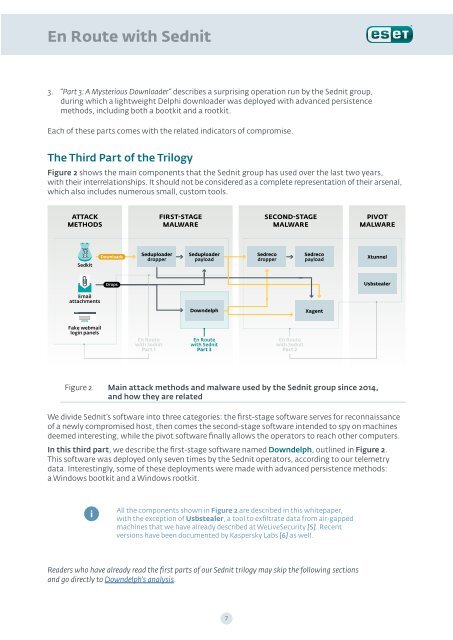En Route with
eset-sednit-part-3
eset-sednit-part-3
You also want an ePaper? Increase the reach of your titles
YUMPU automatically turns print PDFs into web optimized ePapers that Google loves.
<strong>En</strong> <strong>Route</strong> <strong>with</strong> Sednit<br />
3. “Part 3: A Mysterious Downloader” describes a surprising operation run by the Sednit group,<br />
during which a lightweight Delphi downloader was deployed <strong>with</strong> advanced persistence<br />
methods, including both a bootkit and a rootkit.<br />
Each of these parts comes <strong>with</strong> the related indicators of compromise.<br />
The Third Part of the Trilogy<br />
Figure 2 shows the main components that the Sednit group has used over the last two years,<br />
<strong>with</strong> their interrelationships. It should not be considered as a complete representation of their arsenal,<br />
which also includes numerous small, custom tools.<br />
ATTACK<br />
METHODS<br />
FIRST-STAGE<br />
MALWARE<br />
SECOND-STAGE<br />
MALWARE<br />
PIVOT<br />
MALWARE<br />
Sedkit<br />
Seduploader<br />
dropper<br />
Seduploader<br />
payload<br />
Sedreco<br />
dropper<br />
Sedreco<br />
payload<br />
Xtunnel<br />
Usbstealer<br />
Email<br />
attachments<br />
Downdelph<br />
Xagent<br />
Fake webmail<br />
login panels<br />
<strong>En</strong> <strong>Route</strong><br />
<strong>with</strong> Sednit<br />
Part 1<br />
<strong>En</strong> <strong>Route</strong><br />
<strong>with</strong> Sednit<br />
Part 3<br />
<strong>En</strong> <strong>Route</strong><br />
<strong>with</strong> Sednit<br />
Part 2<br />
Figure 2. Main attack methods and malware used by the Sednit group since 2014,<br />
and how they are related<br />
We divide Sednit’s software into three categories: the first-stage software serves for reconnaissance<br />
of a newly compromised host, then comes the second-stage software intended to spy on machines<br />
deemed interesting, while the pivot software finally allows the operators to reach other computers.<br />
In this third part, we describe the first-stage software named Downdelph, outlined in Figure 2.<br />
This software was deployed only seven times by the Sednit operators, according to our telemetry<br />
data. Interestingly, some of these deployments were made <strong>with</strong> advanced persistence methods:<br />
a Windows bootkit and a Windows rootkit.<br />
All the components shown in Figure 2 are described in this whitepaper,<br />
<strong>with</strong> the exception of Usbstealer, a tool to exfiltrate data from air-gapped<br />
machines that we have already described at WeLiveSecurity [5]. Recent<br />
versions have been documented by Kaspersky Labs [6] as well.<br />
Readers who have already read the first parts of our Sednit trilogy may skip the following sections<br />
and go directly to Downdelph’s analysis.<br />
7


